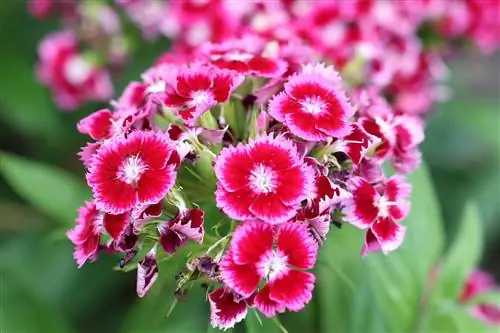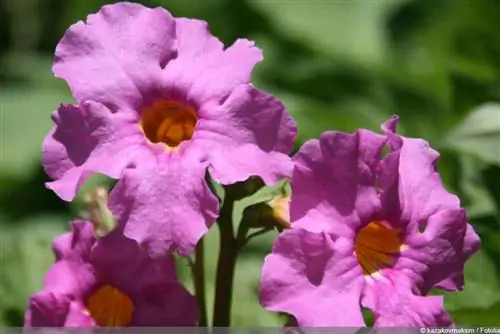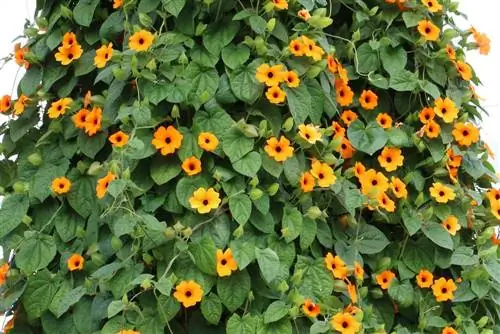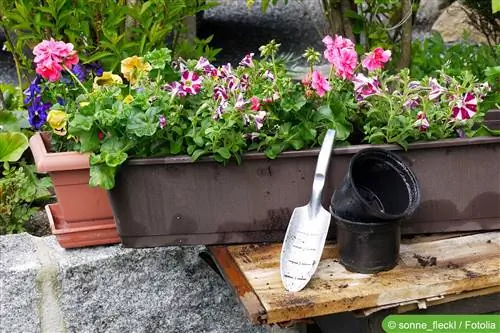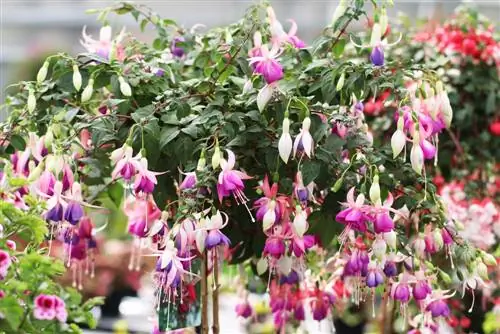- Author admin [email protected].
- Public 2023-12-17 03:39.
- Last modified 2025-01-24 12:45.
Annual plants are typically flowering plants designed to bloom intensively for just one season. The plants neither survive frosty temperatures nor do they usually have the strength to bloom attractively for another season. Many hobby gardeners find this a great shame, because on the one hand they have to invest in new plants for the next season, and on the other hand the planting and design of the tubs and pots has to be implemented again. With a few tricks you can also save annual plants for another season.
Popular annual plants
The Beard Thread
Also called penstemon hybrids, this perennial plant is native to the southern USA and is very decorative in the garden because of its bell-shaped and lush flowers. The plants thrive optimally in warm temperatures and with a sufficient supply of nutrients, which they urgently need for their flowering. The plant can be sown in the greenhouse or on the windowsill from February. The penstemon is also available as a young plant at the garden center and can then be planted outdoors after the Ice Saints in mid-May. With a little skill, you can even get this perennial plant through the winter and enjoy another season.
The Bearded Carnation
The Dianthus barbatus, which comes from southern Europe, has been around as a cultivated ornamental plant for more than 500 years. Today it often adorns cottage gardens. It owes its name to the pointed sepals that form below the flower. The plant appreciates moderately dry and well-drained soil with a good supply of nutrients. If you want to overwinter the bearded carnation, you should cover it with shoots and protect it from the winter cold outside.
Hardworking Lieschen
The Impatiens walleriana is an annual plant that came to Germany from East Africa around 100 years ago and was initially kept as a houseplant. It gets its name because it blooms so much. Due to its character as a houseplant, this plant can also be overwintered indoors and thus turned into a perennial plant, especially since, despite its origins, it prefers cool, moist and quite locations.
Which plants can overwinter despite being annuals?
Flowering plants that are specifically designed to be kept in containers and pots are usually annuals. They flower, form new seeds and die. In addition to the annuals mentioned above, with a little sensitivity you can also try to overwinter the fuchsia, the geranium or even southern plants such as the mallow, the oleander, the olive tree or even citrus plants despite their annual status.
Frequently asked questions
When and how to hibernate?
So that the plants survive the rest phase well, they should be prepared for overwintering so that they no longer receive fertilizer from September onwards. It is important to bring the flowers into the house before the first night frosts. Beforehand, all shoots are cut back and wilted flowers and leaves are also thoroughly removed. The plant must also be checked for pests before overwintering, as it is otherwise very susceptible to their reproduction, especially during the dormant phase. The root ball should dry. Because the winter quarters for annual plants are more of an emergency solution, overwintering indoors should be as short as possible.
Where should you overwinter?
An overwintering place in a bright but cool room is perfect for almost all annual plants. Unheated bedrooms, attics, storage rooms, stairwells or the winter garden are perfect, as long as it is not heated. The basement window can also be chosen as a location. The plant will shed its leaves in the dark, but they will grow back quickly next spring.
Tip:
It is important that the location is not too warm, because then infestation by aphids and mites is much more likely.
What else should you pay attention to?
Because the plant is more susceptible to pest infestation even under perfect conditions and a cool location in the winter quarters, it should be checked regularly and diseased parts of the plant should be removed. It is important that the plant is only watered very moderately during the winter break. This is important because growth is reduced in winter and otherwise there is a risk of root rot. Ventilating the room every now and then is very good for the plant.
Winter indoors
- a cool location
- regular inspection for pests
- water moderately
- ventilate the room occasionally
Winter outside
If potted plants are to overwinter outside, they must be protected from the cold. The best way to do this is to wrap the pot and plant with fleece or jute. Bubble wrap can also be used for this. All plant containers that are left outside in winter must be placed on ledges or other insulating wood or platforms to protect the roots from the cold. This means that the air can circulate perfectly between the pot and the ground and the watering hole at the bottom of the pot does not freeze over.
Overwintering bamboo and roses
These plants need shade and also a windbreak in order to get through the winter well. Wrapped with reed mats or fleece, these plants are perfectly protected. It is important here that the fabric is permeable to air, which is why bubble wrap is not suitable for these plants. The insulating material must also be translucent, otherwise there is a risk of fungal infestation. Roses can be covered with leaves and pine branches in winter and overwinter outdoors, although they prefer a frost-free winter quarters.
The herb garden
Once you have created a beautiful herb garden, you would usually like to use it in this individual combination in the new season. The best way to overwinter the herb garden is in a cardboard box filled with dry leaves, in which the plants are also covered with leaves.
The winter balcony or the winter terrace
Mockberry and Tormyrtle are evergreen plants with red, pink or white berries even in winter, perfect for winter decoration on the terrace or balcony. A wind-protected, shady spot is enough for these plants to get off to a good start in the new season
Tip:
All evergreen plants must continue to be watered during the winter break!
In spring
When spring comes again, the overwintered plants should slowly be warmer and brighter from around the beginning of February. A spot by a sunny window is best. At the beginning of budding, the annual plants are then cut back. When the first leaf growth begins, water and fertilize normally again. Oleanders as well as citrus and olive trees in particular are prone to sunburn, which is why they should first be slowly accustomed to the sun in a shady spot. In spring
- the plants should be used to light and warmth again from the beginning of February.
- move to a sunny window.
- they are cut back when the first leaves emerge.
- they are watered and fertilized again as normal once the leaves grow.
- some sun-sensitive plants need a slow acclimatization in a shady spot.
Frequently asked questions
What to do if my plants didn't survive the winter?
To avoid this danger, you should save seeds of the respective plant in autumn so that you can grow them yourself if in doubt.
Can annual plants be maintained over several winters?
With some plants and optimal care, the plants can survive several winters. However, you should be aware that the plant loses strength with each season and at some point it will no longer bloom or grow particularly luxuriantly.
What you should know about annual plants in brief
Annual plants for the garden are particularly suitable if you want to completely redesign the garden, or at least parts of it, every year. The selection of annual plants for the garden starts with the early bloomers. The spring onions that can be purchased annually and are planted in the ground in the fall are only rarely suitable for use again the following fall. You can also sow other plants that will then remain in the garden as an annual. All seed flowers are included because the small seeds cannot survive a frost. However, some require a severe frost to form a shoot. Popular spring flowers that should be planted in the ground before the first frost are:
- Bluebells,
- Lilies,
- Tulips,
- Violets and
- Primroses
There are also annual plants for which sowing in spring is sufficient because they do not need cold but sunlight and sufficient water. These include:
- all crops,
- various types of cabbage
- and also strawberries
The advantage of most annual plants is that they do not require fertilization, although they can be attacked by numerous pests. Flower bulbs and seeds are already high on the menu of mice and birds, and aphids and spider mites can also be found on some varieties. In addition, some plants are often inhabited by snails. When caring for them, it should also be noted that most annual plants require regular watering, especially if the amount of rain requires it. However, over the course of the year you no longer have to water after heavy rain - however, very few annual plants in the garden are forgiving of long dry periods.

